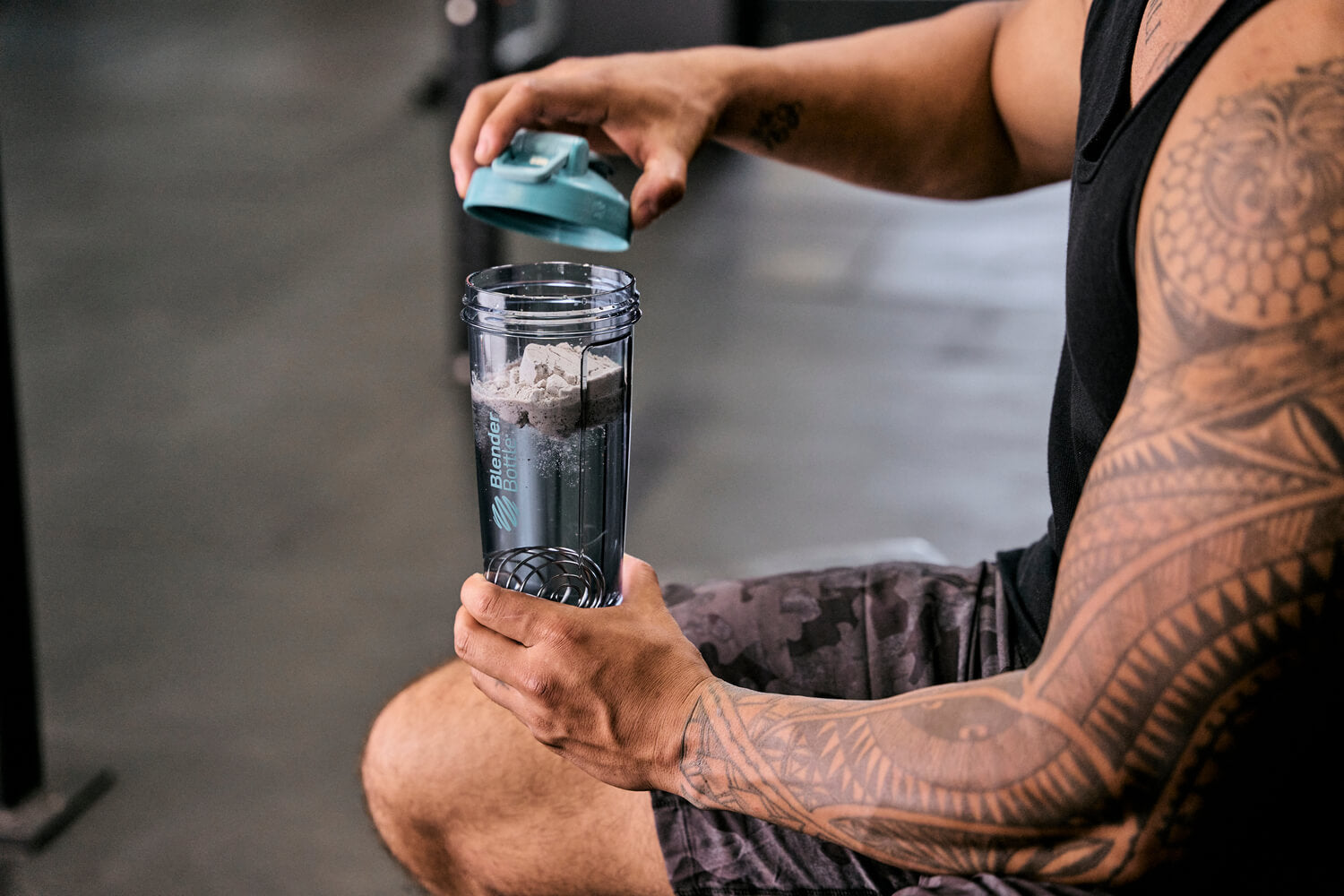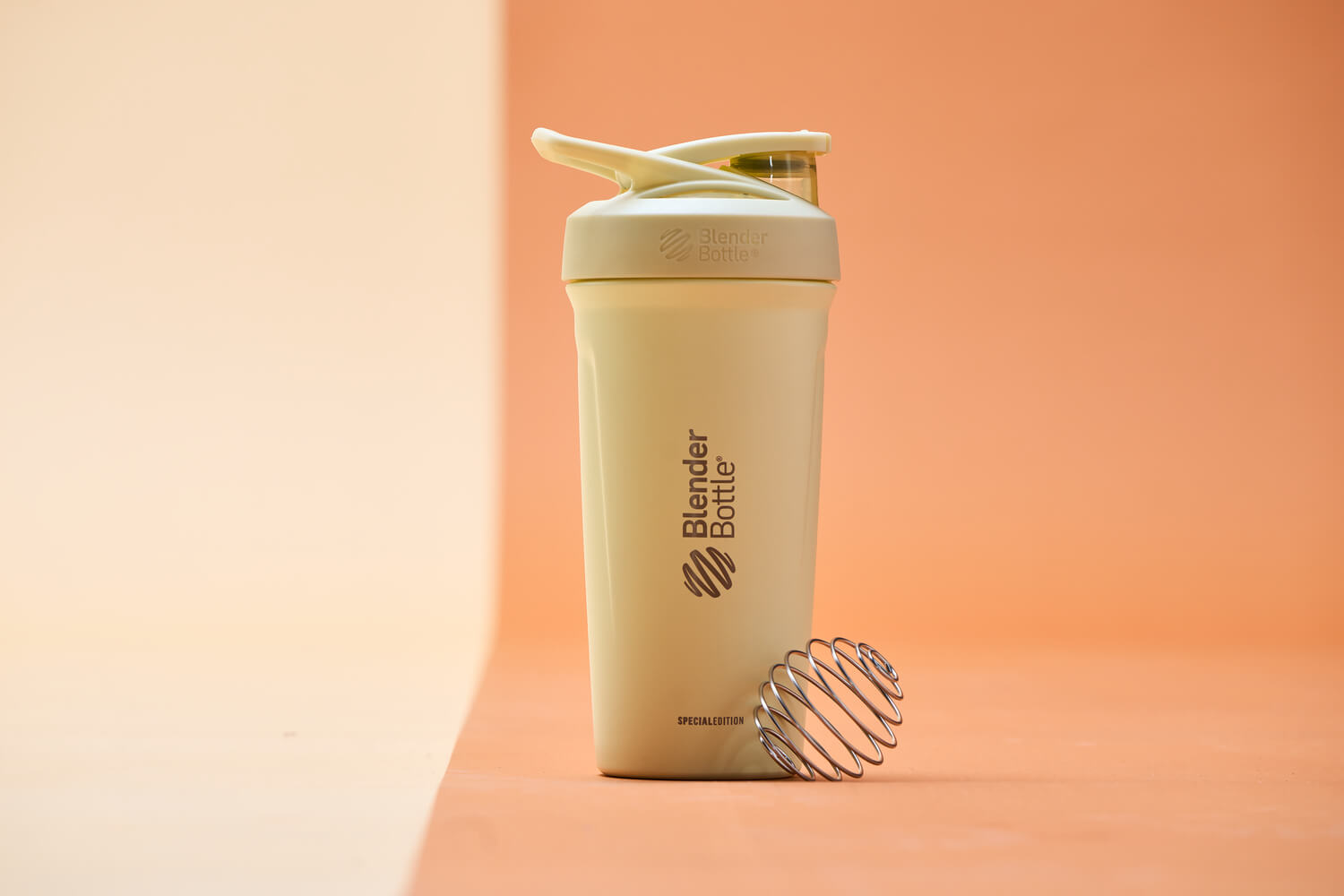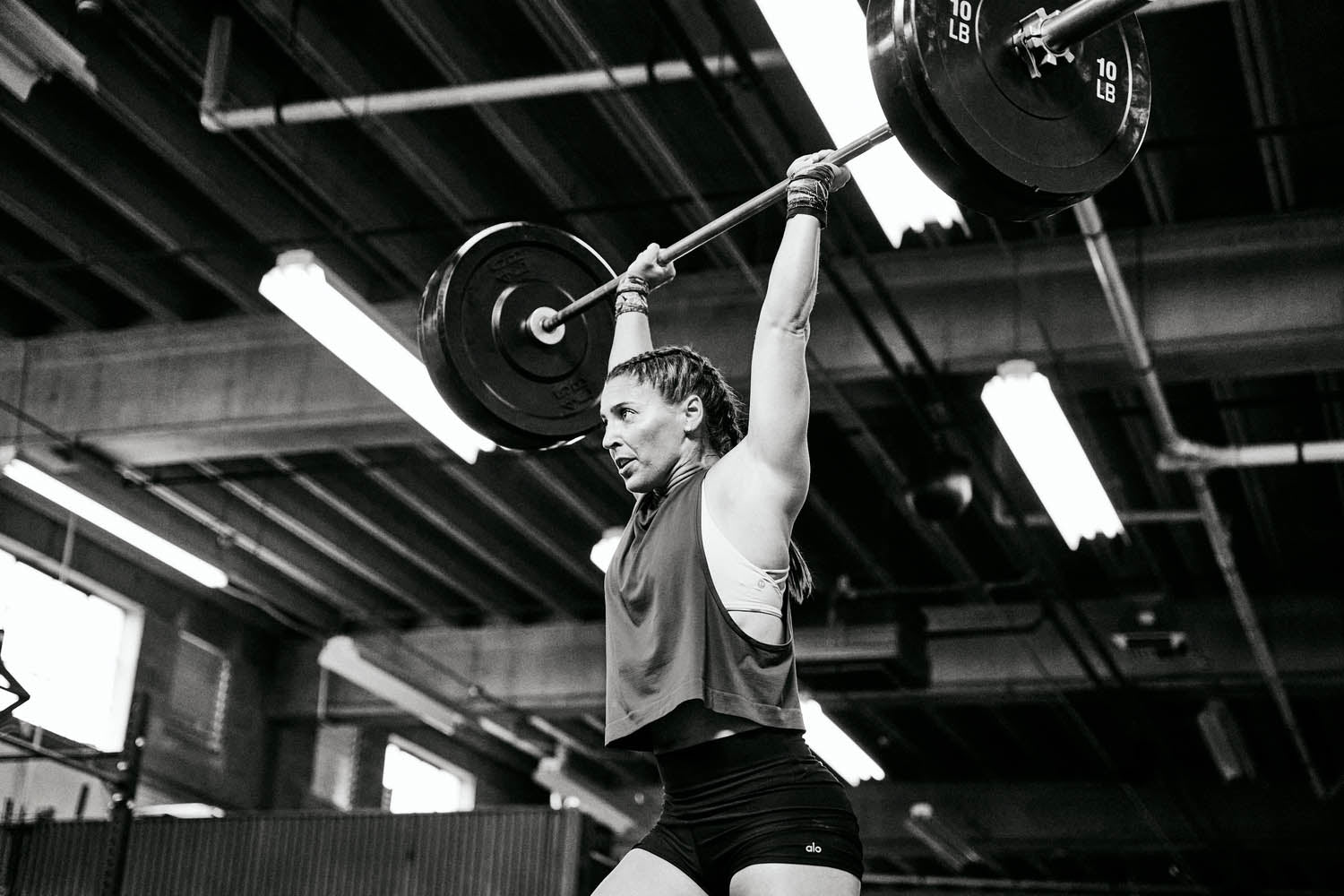Protein shakes have become a staple for fitness enthusiasts, athletes, and health-conscious individuals seeking a convenient and efficient way to fuel their bodies. In the pursuit of a flawless protein shake, proper mixing is key. Join us on a guide to elevate your protein shake game, ensuring each sip is a smooth and lump-free experience.
Step 1: Choosing Your Liquid Base Embark on your protein shake journey by selecting your preferred liquid base – water, milk, or a dairy-free alternative. The choice of liquid sets the foundation for the flavor and texture that follows.
Step 2: Liquid First To circumvent clumping and guarantee a velvety texture, pour your chosen liquid into your BlenderBottle first. This approach establishes a seamless interaction between liquid and powder.
Put your powder in first? No worries, BlenderBottle shaker cups have a rounded base to keep powder out of any corners that other cups have.
Step 3: Add Your Powder Measure the protein powder according to the recommended serving size. Adding the powder after introducing the liquid minimizes adherence to the bottle's surfaces.
Step 4: Blending with Precision Introduce the BlenderBall wire whisk for a flawless shake. Place the whisk inside, secure the lid, and shake for about 10-20 seconds for a lump-free blend.
Step 6: Open and Drink Open the shaker and release any pressure—your BlenderBottle shaker cup now holds the perfect protein shake. Embrace BlenderBottle's precision for a lump-free shake every time.
As you embark on the quest for the perfect protein shake, you may need to troubleshoot common issues that might hinder your quest for a seamless blend. Understanding the following nuances ensures a protein shake experience that is lump free and delicious.
Why is my protein shake so foamy and frothy?
If your protein shake is turning out foamy or frothy, there are a few reasons that might be causing it:
- Mixing Too Vigorously: If you're shaking your BlenderBottle too aggressively, it can introduce air into the protein shake, creating foam. Try shaking it a bit more gently to minimize air incorporation.
- Protein Powder Quality: Some protein powders have ingredients that are prone to foaming. Check the quality of your protein powder and consider trying a different brand if you consistently face this issue.
- Liquid-to-Powder Ratio: Make sure you're using the recommended amount of liquid for the specified serving of protein powder. Too little liquid can result in a thicker mixture that's prone to foaming.
- Temperature: Cold liquids tend to create more foam than room temperature ones. If you're using very cold liquids, try letting them come to room temperature before mixing.
- Protein Content: Protein shakes with higher protein content are more likely to foam. If reducing protein concentration is acceptable for your dietary needs, try using less protein powder.
- Ingredients Interaction: Foaming tends to be more pronounced with pure forms of proteins such as Whey Protein Concentrate or Whey Isolate, which lack fillers or thickening agents. These proteins are in their pure form, contributing to increased frothiness. In contrast, mass gainers or protein blends, containing various ingredients beyond a single protein source, typically produce less foam. Many commercial brands mitigate foaming by incorporating anti-foaming agents like polydimethylsiloxanes or oil-based defoamers. Additionally, binding agents like gelatin or egg protein are sometimes added to create a thicker consistency in shakes, minimizing foam production. Understanding the composition of your protein powder can help tailor your mixing technique for optimal results (1).
Why is my protein shake so chunky and lumpy?
If your protein shake is coming out chunky and lumpy, here are a few reasons why that might be happening:
- Incomplete Mixing: It's possible that you're not shaking your BlenderBottle long enough or vigorously enough. Ensure that you're giving it a thorough mix to break down the protein powder and achieve a smoother consistency.
- Liquid-to-Powder Ratio: Double-check the recommended liquid-to-powder ratio on your protein powder container. Too little liquid can result in an insufficient environment for proper powder dissolution, leading to lumps.
- Quality of Protein Powder: The quality and type of protein powder can influence its mixability. Some protein powders may have a tendency to clump. Experimenting with different brands or protein types might help you find one that dissolves more smoothly.
- Temperature of Liquid: Cold liquids can sometimes cause protein powder to clump. If you're using cold liquids, consider letting them come to room temperature before mixing.
- Protein Powder Age: Protein powder can form clumps over time, especially if exposed to moisture. Check the expiration date and storage conditions of your protein powder, and if it's old or has been stored improperly, it might be time for a new container.
- Use The BlenderBall: Make sure you're using the included mixing ball to assist in breaking down the protein powder and preventing clumps. The BlenderBall whisk helps create better fluid dynamics for smoother mixing.
- Proper Mixing Order: Always add liquid first before adding powders. This ensures that the powder is dispersed more evenly and has a better chance of fully dissolving, reducing the likelihood of lumps.
Why is my protein shake so thick?
If your protein shake is turning out unusually thick, here are a few reasons why that might be happening:
- Liquid-to-Powder Ratio: Check the recommended liquid-to-powder ratio on your protein powder container. Using too little liquid with the recommended amount of powder can result in a thicker consistency. Adjusting the ratio to have more liquid may help.
- Protein Content: Some protein powders are formulated with higher protein concentrations, leading to a thicker shake. Consider trying a protein powder with a slightly lower protein content if you prefer a thinner consistency.
- Mixing Time: Overmixing your protein shake can also contribute to a thicker texture. Shake your BlenderBottle until the powder is fully dissolved, but avoid excessive shaking, which can lead to a denser shake.
- Temperature: Cold liquids tend to thicken protein shakes more than room temperature ones. If you're using very cold liquids, allowing them to reach room temperature before mixing might help.
- Type of Protein Powder: Certain types of protein, like casein, can naturally create a thicker texture. If your protein powder contains casein or other thickeners, this could be contributing to the thickness.
- Use a BlenderBottle: Ensure you're using your BlenderBottle with the mixing ball to help break down the protein powder effectively. The ball aids in creating a smoother consistency.
- Proper Mixing Order: Always add liquid first before adding powders. This helps in achieving a more uniform distribution of the powder and prevents clumping, contributing to a smoother and less thick shake.
Why is my protein shake fizzing and sizzling?
If your protein shake is fizzing and sizzling, here are a few reasons that might be causing it:
- Rapid Mixing: Shaking your BlenderBottle too quickly or vigorously can introduce air into the mixture, causing it to fizz. Try shaking it more gently to minimize air incorporation.
- Temperature: Mixing protein powder with very cold liquids can sometimes create a fizzy reaction. Allowing your liquid to come to room temperature before mixing may reduce fizziness.
- Expired or Contaminated Protein Powder: Check the expiration date on your protein powder container. If the powder is past its expiration date or has been contaminated, it may react unpredictably and produce fizz. Ensure that your protein powder is stored in a cool, dry place.
- Interaction with Other Ingredients: Some protein powders may react with certain ingredients, causing fizziness. Review the ingredients list on your protein powder container and consider experimenting with different liquids or additives.
- Protein Powder Composition: Certain protein powders, especially those with added amino acids or other compounds, might have properties that contribute to fizzing. Understanding the composition of your protein powder can help you determine the cause.
Additionally, when opening the bottle after shaking, do so slowly to release any remaining pressure and avoid potential spills.
Why is my protein shake gritty in texture?
If your protein shake has a gritty texture, a few factors might be contributing to it:
- Incomplete Mixing: Ensure you're shaking your BlenderBottle thoroughly and for a sufficient duration to break down the protein powder completely. Inadequate mixing can leave undissolved particles, resulting in a gritty texture.
- Liquid-to-Powder Ratio: Double-check the recommended liquid-to-powder ratio on your protein powder container. Using too little liquid for the specified amount of powder can lead to incomplete dissolution and a grainy consistency.
- Quality of Protein Powder: The type and quality of protein powder you use can affect its mixability. Cheaper or lower-quality powders may contain larger particles that don't dissolve as easily, contributing to grittiness.
- Temperature: Cold liquids may make it challenging for the protein powder to dissolve completely. Allow your liquid to reach room temperature before mixing to promote better dissolution.
- Protein Powder Age: Check the expiration date on your protein powder container. Expired or old protein powder may clump and result in a gritty texture.
- Use a BlenderBottle: Utilize the BlenderBottle with the BlenderBall wire whisk to facilitate better blending and prevent grittiness. The ball helps break down clumps and promotes a smoother texture.
- Type of Protein: Certain types of protein, like plant-based proteins, may have a naturally grittier texture. If you're using a plant-based protein, experimenting with different brands or types might help you find a smoother option. High-quality whey protein will mix easier than some of its counter parts.
- Proper Mixing Order: Always add liquid first before adding powders. This helps in achieving a more uniform distribution of the powder and prevents clumping, contributing to a smoother shake.
With the right approach and the help of your BlenderBottle, you can easily overcome the common challenges associated with protein shakes. Remember to follow the order of adding ingredients, use the BlenderBall whisk for efficient mixing, and adjust ratios to achieve your desired taste and consistency. By mastering these techniques, you'll be well on your way to enjoying perfectly smooth and delicious protein shakes every time you use your BlenderBottle.
Sources
1. Muscle, Nectar. “Is Foaming in Whey Protein Shake Causing You a Concern?” Muscle Nectar, 25 Oct. 2019, musclenectar.com/blogs/blog/is-foaming-in-whey-protein-shake-causing-you-a-concern. Accessed 12 Feb. 2024.





Leave a comment
All comments are moderated before being published.
This site is protected by reCAPTCHA and the Google Privacy Policy and Terms of Service apply.